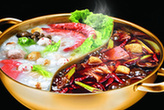Photo taken on June 30, 2011, shows the animated version of ancient painting Riverside Scene at the Qingming Festival in Taipei, southeast China's Taiwan. The animated version of the Qingming scroll, a highly renowned piece of Chinese painting dating back some 900 years ago, started to be exhibited in Taipei on Thursday. The painting will be projected onto a six-meter-high and 110-meter-wide screen, magnified by 10 times of the scroll's original size. (Xinhua/Li Mingfang) |
Features of the Song original
In the 5.28-meter long picture, there are 814 humans, 28 boats, 60 animals, 30 buildings, 20 vehicles, nine sedan chairs, and 170 trees drawn.[8][9] The countryside and the densely populated city are the two main sections in the picture, with the river meandering through the entire length.
The right section is the rural area of the city. There are crop fields and unhurried rural folk—predominately farmers, goatherds, and pig herders—in bucolic scenery. A country path broadens into a road and joins with the city road.
The left half is the urban area, which eventually leads into the city proper with the gates. Many economic activities, such as people loading cargoes onto the boat, shops, and even a tax office, can be seen in this area. People from all walks of life are depicted: peddlers, jugglers, actors, paupers begging, monks asking for alms, fortune tellers and seers, doctors, innkeepers, teachers, millers, metalworkers, carpenters, masons, and official scholars from all ranks.
Outside the city proper (separated by the gate to the left), there are businesses of all kinds, selling wine, grain, secondhand goods, cookware, bows and arrows, lanterns, musical instruments, gold and silver, ornaments, dyed fabrics, paintings, medicine, needles, and artifacts, as well as many restaurants. The vendors (and in the Qing revision, the shops themselves) extend all along the great bridge, called the Rainbow Bridge (虹桥 Hong Qiao) or, more rarely, the Shangtu Bridge (上土桥).
Where the great bridge crosses the river is the center and main focus of the scroll. A great commotion animates the people on the bridge. A boat approaches at an awkward angle with its mast not completely lowered, threatening to crash into the bridge. The crowds on the bridge and along the riverside are shouting and gesturing toward the boat. Someone near the apex of the bridge lowers a rope to the outstretched arms of the crew below.
In addition to the shops and diners, there are hotels, temples, private residences, and official buildings varying in grandeur and style, from huts to mansions with grand front- and backyards.
People and commodities are transported by various modes: wheeled wagons, beasts of labor (in particular, a large number of donkeys and mules), sedan chairs, and chariots. The river is packed with fishing boats and passenger-carrying ferries, with men at the river bank, pulling the larger ships.





Why not rent a boyfriend, or girlfriend to please parents during the Spring Festival?